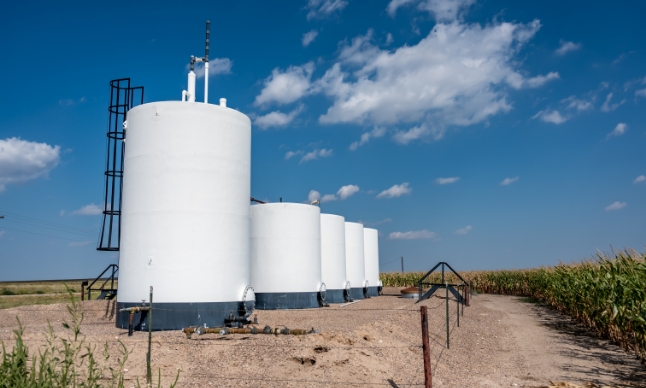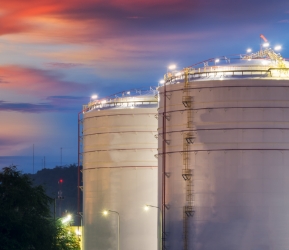Call Us: 1.800.275.3453
Request a QuoteCall Us: 1.800.275.3453
Request a QuoteTransformers play a vital role in power generation and distribution. However, with oil capacities that can exceed 30,000 gallons, equipment failure, extreme weather, or aging infrastructure could cause a substantial spill. A single leak can lead to costly environmental damage, regulatory penalties, and system downtime.
Since transformers vary widely in size, location, and operational demands, they need customized transformer oil containment systems to address factors like uneven terrain, proximity to sensitive ecosystems, and SPCC regulations.

In this Article:
Although not on the same scale as pipeline or tanker spills, the localized risks of transformer oil spills are significant. A leak can contaminate ecosystems and drinking water and halt power distribution during cleanup and repair efforts.
Containment systems are necessary to catch any oil that escapes from a transformer. Smaller installations with limited space could benefit from a compact pan, while large volumes of oil require a complete containment system solution.
Primary containment systems are designed to collect and hold oil spills at the source. These systems include drip trays, containment pads, or built-in basins placed beneath the transformer to capture any oil that escapes during normal operation or due to minor leaks.
Primary systems are the first line of defense in oil spill management. For example, a containment pad underneath a transformer will collect oil and prevent it from seeping into the ground.
Construction materials like steel and reinforced fiberglass resist oil and environmental degradation. In addition, primary systems often feature drain ports for maintenance and oil removal.
Secondary containment systems are barriers that prevent oil from escaping into the environment in the event of a major spill or if primary containment fails. These include bunded areas, dikes, or modular containment walls.
Secondary systems hold larger volumes than primary systems, often 110% or more of the transformer’s oil capacity as SPCC regulations require. A bunded area with a liner around the transformer, for instance, will capture any oil overflow from a catastrophic failure and prevent it from reaching nearby soil or waterways.
Secondary systems provide redundancy for safety and compliance and mitigate the environmental impact of larger spills.
The EPA’s Spill Prevention, Control, and Countermeasure regulations aim to protect navigable waters, shorelines, and inland soil from oil spill contamination.

SPCC regulations apply to facilities that store 1,320 gallons or more of oil above ground. Any container, including a transformer, that holds at least 55 gallons of oil counts toward this total. Transformer oil containment requirements include:
If secondary transformer spill containment is impractical, facilities with contingency plans, preventive measures, and regular monitoring may qualify for an exemption.
The EPA enforces SPCC violations, which may involve the following:
These repercussions are distinct from the broader risks, including environmental, financial, reputational, and legal consequences, of an uncontained transformer spill.
Polystar specializes in secondary systems for oil containment for transformers. We will collaborate with you to engineer a tailored configuration for your power generation application using these products.
We designed our Containment Pad™ for capturing oil spills and drips from transformers.
Containment Pad™ features include:
They are also available with optional safety railings that keep workers safe and prevent falls.
Containment Pad™ benefits are as follows:
Our pads meet SPCC transformer containment standards.
The Poly Dike MPE® is a modular secondary containment wall system for oil-filled equipment like transformers.
The Poly Dike MPE® includes notable features such as:
We’ve also engineered the Poly Dike for portability so you can easily relocate or store it when it’s not in use.
Our Poly Dike MPE® offers these benefits:
By providing reliable secondary containment, these adhere to SPCC regulations.
At Polystar, we have been manufacturing durable, reliable transformer oil containment systems for over 20 years. We’re here to provide you with customized products that address all your environmental, safety, and regulatory concerns. We will work closely with you to find the best secondary containment solution for your facility. Contact us today.
Request a QuoteHere are a few routine questions about oil containment for transformers that we have addressed.
Without a containment pan, transformer oil leaks or spills can seep into the soil, contaminate nearby water sources, and require expensive cleanup. Facilities may face fines or legal action for violating environmental regulations like SPCC.
The SPCC requires an oil-resistant containment system large enough to hold 110% of the transformer’s oil volume and with regular inspections for integrity. Facilities should develop an SPCC plan with spill response protocols and secondary containment systems.
Transformer oil containment pans minimize environmental risks, protect against regulatory fines, and reduce potential cleanup costs. They also increase operational safety and demonstrate environmental responsibility.
